Iraqi
girl's education: challenges and opportunities
Safaa
Bahjat
Correspondence:
Dr Safaa Bahjat
Allergologist,
Kirkuk
Iraq
Email: docbahjatsafaa2000@googlemail.com
|
To
Whom Is Concerned!
A
coalition to fight ISIS has been launched;
again this is another open war with no
time table, and the battlefield is Iraq,
the world's favoured weapon trials laboratory
on the experimental models Iraqis by the
justificatory rhetoric of war (collateral
damage!).
"What
hypocrisy when some people grow 'indignant'
because one or two of their citizens are
killed".
War has been
described as 'development in reverse'.
Even short episodes of armed conflict
can halt progress or reverse gains built
up over generations, undermining economic
growth and advances in health, nutrition
and employment. The impact is most severe
and protracted in countries and among
people whose resilience and capacity for
recovery are weakened by mass poverty
.Education seldom figures in assessments
of the damage inflicted by conflict. International
attention and media reporting invariably
focus on the most immediate images of
humanitarian suffering, not on the hidden
costs and lasting legacies of violence.
Yet nowhere are those costs and legacies
more evident than in education. Across
many of the world's poorest countries,
armed conflict is destroying not just
school infrastructure, but also the hopes
and ambitions of a whole generation of
children.
Education is seldom a primary cause of
conflict. Intra-state armed conflict is
often associated with grievances and perceived
injustices linked to identity, faith,
ethnicity and region. Education can make
a difference in all these areas, tipping
the balance in favour of peace -or conflict.
When the political leaders do acknowledge
the need to tackle literacy,(allow Iraqis
to extend their knowledge through free
fellowships in the developed countries)
only then they will guarantee winning
the war.
Dr. Safaa
Bahjat
|
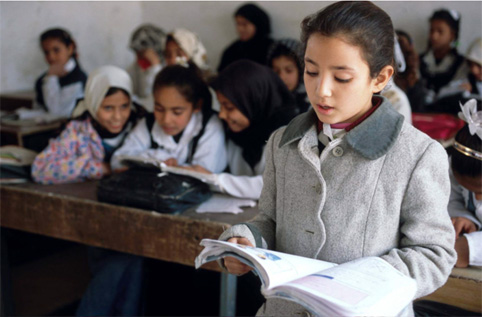
The girls in the photo say; 'I want to become
an attorney and be an important person';' I
want to become a teacher'; 'I keep coming to
school because I am a top performer and I want
to finish my education'; ' I like to go to school
and learn';' I want to learn how to read and
write.'
All the available data and available published
information make it clear that Iraq's women, once
a highly educated group, have lost ground in the
last 15 -20 years as girls' participation in education
has declined. A good quality educational system,
which includes and encourages the full participation
of girls, is vital for any country's development.
The full participation of girls is needed not
only because of the value of the contribution
that women are then able to make in social, economic
and political spheres, but because of the well
documented benefit that the educational level
of the wife and mother in a family makes to the
health, well-being and success in life of all
family members. The value of providing good education
for all children is even greater in the case of
Iraq because of the immense development tasks
facing the country. However the available information
suggests that educational disadvantage is increasing
for Iraqi girls as they are disproportionally
less likely to participate and succeed in education
at every age and every level. Half the future
of the country is being wasted. Educational disadvantage
for girls in Iraq has complex causes. It is inextricably
linked with the status of women in Iraqi society
and with the opportunities available to women
in the workplace and in public life, as well as
with social conditions such as poverty, security
and the quality of educational provision.
Although historically Iraqi women and girls had
relatively more rights than many of their counterparts
in the Middle East, major discrepancies have always
existed between rich and poor, urban and rural,
traditional and liberal families with regard to
the education of girls. The Iraqi Provisional
Constitution (drafted in 1970) formally guaranteed
equal rights to women and other laws specifically
ensured their right to vote, attend school, run
for political office, and own property. Since
the 1991 Gulf War, the position of women within
Iraqi society has deteriorated rapidly, with the
predictable impact on girls' education. Women
and girls were disproportionately affected by
the economic consequences of the U.N. sanctions,
and lacked access to food, health care, as well
as education. These effects were compounded by
changes in the law that restricted women's mobility
and access to the formal sector in an effort to
ensure jobs to men and appease conservative religious
and tribal groups.
After seizing power in 1968, the secular Ba'ath
party embarked on a programme to consolidate its
authority and to achieve rapid economic growth
despite labour shortages. Women's participation
was integral to the attainment of both of these
goals, and the government passed laws specifically
aimed at improving the status of women. The status
of Iraqi women was directly linked to the government's
over-arching political and economic policies.
Until the 1990s, Iraqi women played an active
role in the political and economic development
of Iraq. A robust civil society had existed prior
to the coup d'état in 1968, including a
number of women's organizations. The Ba'ath Party
dismantled most of these civil society groups
after its seizure of power. Shortly thereafter
it established the General Federation of Iraqi
Women. The General Federation of Iraqi Women played
a significant role in implementing state policy,
primarily through its role in running more than
250 rural and urban community centers offering
job-training, educational, and other social programmes
for women and acting as a channel for communication
of state propaganda. Female officers within the
General Federation of Iraqi Women also played
a role in the implementation of legal reforms
advancing women's status under the law and in
lobbying for changes to the personal status code.
The primary legal underpinning of women's equality
was set out in the Iraqi Provisional Constitution,
which was drafted by the Ba'ath party in 1970.
Article 19 declares all citizens equal before
the law regardless of sex, blood, language, social
origin, or religion. In January 1971, Iraq also
ratified the International Covenants on Civil
and Political Rights and Economic, Social and
Cultural Rights which provide equal protection
under international law to all.
In order to further its programme of economic
development, the government passed a compulsory
education law mandating that both sexes attend
school at the primary level. The Compulsory Education
Law 118/1976 stated that education is compulsory
and free of charge for children of both sexes
from six to ten years of age. Girls were free
to leave school thereafter with the approval of
their parents or guardians. Although middle and
upper class Iraqi women had been attending university
since the 1920s, rural women and girls were largely
uneducated until this time. In December 1979,
the government passed further legislation requiring
the eradication of illiteracy. All illiterate
persons between ages fifteen and forty-five were
required to attend classes at local "literacy
centers," many of which were run by the General
Federation of Iraqi Women(GFIW). Although many
conservative sectors of Iraqi society refused
to allow women in their communities to go to such
centers (despite potential prosecution), the literacy
gap between males and females narrowed. The Iraqi
government also passed labour and employment laws
to ensure that women were granted equal opportunities
in the civil service sector, maternity benefits,
and freedom from harassment in the workplace.
Such laws had a direct impact on the number of
women in the workforce. The fact that the government
was hiring women contributed to the breakdown
of the traditional reluctance to allow women to
work outside the home. The Iraqi Bureau of Statistics
reported that in 1976, women constituted approximately
38.5 percent of those in the education profession,
31 percent of the medical profession, 25 percent
of lab technicians, 15 percent of accountants
and 15 percent of civil servants.
During the Iran-Iraq war (1980-88), women assumed
greater roles in the workforce in general and
the civil service in particular, reflecting the
shortage of working age men. Until the 1990s,
the number of women working outside the home continued
to grow.
Legislative reforms in this period reflected the
Ba'ath Party's attempt to modernize Iraqi society
and supplant loyalty to extended families and
tribal society with loyalty to the government
and ruling party. In the years following the 1991
Gulf War, many of the positive steps that had
been taken to advance women's and girls' status
in Iraqi society were reversed because of a combination
of legal, economic, and political factors. The
most significant political factor was Saddam Hussein's
decision to embrace Islamic and tribal traditions
as a political tool in order to consolidate power.
In addition, the U.N. sanctions imposed after
the war have had a disproportionate impact on
women and children, especially girls. The gender
gap in school enrolment (and subsequently female
illiteracy) increased dramatically due to families'
financial inability to send their children to
school. When faced with limited resources, many
families chose to keep their girl children at
home. According to the United Nations Educational,
Scientific and Cultural Organization (UNESCO),
as a result of the national literacy campaign,
as of 1987 approximately 75 percent of Iraqi women
were literate; however, by year-end 2000, Iraq
had the lowest regional adult literacy levels,
with the percentage of literate women at less
than 25 percent.
Women and girls have also suffered from increasing
restrictions on their freedom of mobility and
protections under the law, which again predictably
impact on the access of girls to education. In
collusion with conservative religious groups and
tribal leaders, the government issued numerous
decrees and introduced legislation which had a
negative impact on women's legal status in the
labour code, criminal justice system, and personal
status laws. In 2001, the U.N. Special Rapporteur
for Violence against Women reported that since
the passage of the reforms in 1991, an estimated
4,000 women and girls had been victims of so called
"honour killings."
Additionally, as the economy constricted, in an
effort to ensure employment for men the government
pushed women out of the labour force and into
more traditional roles in the home, so that the
education of girls became less significant as
they were unlikely to work outside the home. In
1998, the government reportedly dismissed all
women working as secretaries in governmental agencies.
In June 2000, it also reportedly enacted a law
requiring all state ministries to put restrictions
on women working outside the home. Women's freedom
to travel abroad was also legally restricted and
formerly co-educational high schools were required
by law to provide single-sex education only, further
reflecting the reversion to religious and tribal
traditions. As a result of these combined forces,
by the last years of Saddam Hussein's government
the majority of women and girls had been relegated
to traditional roles within the home and the education
of girls had, predictably declined still further.
By 2000, budget constraints were also seriously
limiting the provision of textbooks and other
teaching and learning materials. Less money was
available to rehabilitate dilapidated school so
children were increasingly unable to study in
properly functioning school buildings. The war
begun in 2003 further contributed to the decline
in the quality of education with the greatest
impact on the education of girls with an increase
in both real and perceived levels of danger outside
the home, declining quality teaching and an increase
of religious conservatism in some parts of the
country.
Currently, despite some positive achievements
in northern and southern Iraq, ongoing violence
is posing new challenges in the country's central
zone. In an insecure atmosphere where schools
have been targeted, many parents have to choose
between education and safety for their children,
with girls once again the most affected.
When wars break out, international attention and
media reporting invariably focus on the most immediate
images of human suffering. Yet behind these images
is a hidden crisis. Across many of the world's
poorest countries, armed conflict is destroying
not just school infrastructure, but the hopes
and ambitions of generations of children. Half
of them are girls. The hidden crisis in education
in conflict-affected states is a global challenge
that demands an international response. As well
as undermining prospects for boosting economic
growth, reducing poverty and achieving the Millennium
Development Goals, armed conflict is reinforcing
the inequalities, desperation and grievances that
trap countries in cycles of violence.
Displaced populations are among the least visible
Mass displacement is often a strategic goal for
armed groups seeking to separate populations or
undermine the livelihoods of specific groups.
At least 500 000 people in Mosul have been displaced,
according to the International Organization for
Migration (IOM). 100 000 of these people are being
hosted in Kirkuk, Erbil, Duhauk and Sulaimanya,
while 200 000 people who were not able to pass
through border checkpoints remain located in disputed
areas adjacent to the Kurdish border. A further
200 000 people have been displaced from the west
to the east side of Mosul. An additional 470 000
people were displaced earlier by fighting between
the Iraqi army and armed opposition groups who
have controlled the cities of Ramadi and Fallujah
since January. The new flood of displaced people
from Mosul almost doubled Iraq's internally displaced
persons caseload in less than 1 week and "created
an alarming environment in Iraq", though
the real number is almost certainly higher. Recent
estimates suggest that almost half of refugees
and internally displaced people (IDPs) are under
18. Many do not have the documents.
Gender parity in education is a fundamental
human right, a foundation for equal opportunity
and a source of economic growth, employment
and innovation. Gender disparities originate
at different points in the education system.
Tackling gender disparities in secondary school
poses many challenges. Some of the barriers
to gender parity at the primary level are even
higher at the secondary level. Secondary schooling
is far more costly, often forcing households
to ration resources among children. Where girls'
education is less valued, or perceived as generating
lower returns, parents may favour sons over
daughters. Early marriage can act as another
barrier to secondary school progression. Parents
may also worry more about the security of adolescent
girls because secondary schools are often further
from home than primary schools. The case for
gender fairness in education is based on human
rights, not economic calculus. Schooling can
equip girls with the capabilities they need
to expand their choices, influence decisions
in their households and participate in wider
social and economic processes. By the same token,
there is clear evidence that economic returns
to female education are very high - and, at
the secondary level, higher than for boys. The
implication is that countries tolerating high
levels of gender inequality in education are
sacrificing gains in economic growth, productivity
and poverty reduction, as well as the basic
rights of half the population. When girls enter
school they bring the disadvantages associated
with wider gender inequality, which are often
transmitted through households, communities
and established social practices. Education
systems can weaken the transmission lines, but
building schools and classrooms and supplying
teachers is not enough. Getting girls into school
and equipping them with the skills they need
to flourish often require policies designed
to counteract the deeper causes of gender disadvantage.
Public policy can make a difference in three
key areas: creating incentives for school entry,
facilitating the development of a 'girl-friendly'
learning environment and ensuring that schools
provide relevant skills. In most cases, simultaneous
interventions are required on all three fronts.
In Iraq young girls are less likely to enter
the school system and more likely to drop out
of primary school, and few make it through secondary
school. Interlocking gender inequalities associated
with poverty, labour demand, cultural practices
and attitudes to girls' education create barriers
to entry and progression through school and
reduce expectations and ambition among many
girls.
In Iraq the overall number of children receiving
primary education has declined between 2004-05
and 2007-08 by 88,164, with no improvement in
the percentage of girls enrolled. Gross enrolment
figures provided for the academic year 2005
- 2005 show 5,163,440 children enrolled in primary
education. Girls account for 44.74% of students.
Figures for 2007-2008 show 5,065,276 children
enrolled in primary education, with 44.8 % being
girls. This means that for every 100 boys enrolled
in primary schools in Iraq, there are just under
89 girls. This under representation of girls
in primary school in Iraq has been known for
many years. The fact that there are declining
numbers of girls in each successive grade has
also been identified by analyses of the data.
Analysis of the 2007 -2008 data shows the same
picture. In every governorate a smaller percentage
of girls than boys start school. There are no
governorates where the number of children completing
primary education is acceptable, and it is even
less acceptable for girls. The current data
replicates previously available data in showing
a generally declining percentage of girls in
each successive primary school grade. Some 75%
of girls who start school have dropped out during,
or at the end of, primary school and so do not
go on to intermediate education. Many of them
will have dropped out after grade 1. When all
governorates' figures are combined, there are
21.66% fewer girls in grade 2 than in grade
1. Similarly there is a 28.63% national drop
in the number of girls between grades 5 and
6. By the first intermediate class, only 25%
the number of girls in grade 1 are in school;
by the third intermediate class the figure is
20%.The percentage of girls in primary school
classes is highest in Erbil, Dohuk and Sulaimaniya.
These three governorates also have the highest
percentage of children in pre-school education.
In Erbil 15.8% of children attend preschool
provision, Dohuk 11.3% and Sulaimaniya 11.4%
compared with, for example 5.7% in Baghdad,
8.6% in Kirkuk, or 3.3% in Diyala. There is
also a major issue with the number of children
in each grade who are over age. The difference
between gross and net enrolment data for 2007-08
shows that 659,896 children are above the age
for the grade that they are in. This represents
13% of all primary school children - more than
one in every ten. Of those children, 228,829
children were still attending primary school
when they were aged 13 - 15+.The net enrolment
rate for girls is 45.8%, as against a gross
enrolment rate of 44.8%. This shows a significantly
greater number of overage boys than girls. For
example, only one third of teenagers still in
primary schools were girls.
In order to increase girls' participation in
education, it is vital to gain an insight into
why they never attend school or drop out before
completing their basic education. A small scale
survey of 80 Iraqi girls was therefore included
in the piece of work. While this is not a large
or statistically valid sample, their responses
provide a clear insight into many of the reasons
why girls do not go to school. As would be expected,
parents, particularly fathers, play a major
role in whether the girls can attend school
or not. The girls refer to a range of reasons
why families do not support girls attending
school. These include concerns about safety,
family poverty, a reluctance to allow adolescent
girls to continue to attend school, the distance
from home to school, early marriage and the
need to help at home. The journey to and from
school presents problems caused by fast traffic,
dogs or boys. Girls are frequently demotivated
by the behaviour of teachers who beat them,
distress them and are unwilling to explain subject
matter that a student does not understand. Their
answers make frequent references to being beaten
or insulted by teachers, and to teachers being
unwilling to give explanations in lessons or
support students in their learning. The girls
describe their schools as unwelcoming and unpleasant
with too few facilities and resources. Schools
are described as dirty, poorly maintained and
uncomfortable, with dirty lavatories and no
drinking water available. Safety is an issue,
particularly in areas of major instability and
insecurity. The concerns about safety relate
to both military conflict and civil crime such
as abduction and rape.
To address the issues identified, sets of recommendations
are included in the report for the government
and education services in Iraq, to address key
policy issues and their implementation; Those
for the government focus on policy development
and implementation are, awareness-raising, school
improvement and development, pre-service and
in-service teacher training, curriculum development,
alternative education strategies, and security
for girls travelling to and from school.
The education system is facing a number of major
difficulties. The system is chronically underfunded
and is currently unable to respond to the demands
despite efforts being made to improve the situation
Even where conditions are improving, a significant
number of older children and young adults have
missed out on crucial phases of their education
and there are few opportunities for them to
make good the years they have lost. The factors
that contribute to placing Iraqi girls at an
educational disadvantage and which need to be
addressed through educational policy and its
implementation include:
_ Lack of a school place;
_ Shortage of teachers, particularly experienced
teachers;
_ The unacceptable behaviour of some teachers
and principals;
_ Dirty and dilapidated school buildings which
lack basic facilities;
_ Attitudes to girls' education;
_ Lack of security;
_ Lack of transport when distances are considerable
or the journey is hazardous;
_ Poverty; no money for clothing and school
supplies and other indirect costs of going to
school;
_ Disability;
_ Being needed in the home;
_ Being needed to make a contribution to the
family's business or income;
_ Lack of official papers
Issues related to school infrastructure
If girls are to attend school, there must be
a school for them to attend and teachers to
teach them. Currently, there is an insufficient
number of schools in good repair, with basic
facilities for all girls to receive their entitlement
to schooling and it is often difficult for girls
to travel to and from school and there are particular
issues when intermediate schools are situated
outside the communities in which girls live.
The third most frequent response to the question
as to why girls between 6 and 17 who are not
in school are not attending was that no school
was available nearby. The number and location
of schools, and their capacity, must therefore
become a key educational issue for each governorate.
There are places where schools are not available
locally and some schools are very overcrowded
and some have too few pupils. If universal basic
education is to be achieved, there must be a
school place for every child. This cannot be
achieved easily or quickly, but an analysis
of the number of school places needed, and where
they are needed, could lead to an effective
and realistic action plan to provide them. An
adequate number of school places would encourage
more girls to enrol in school and decrease the
need for the shift system, which many girls
in the survey indicated that they disliked.
The rehabilitation of dirty and dilapidated
school buildings which lack basic facilities
must also be a policy priority if girls are
to be encouraged to participate in education.
In many cases the quality of the physical environment
does not encourage girls to go to school. Many
schools are in poor repair, are being used for
other purposes or have been destroyed. The lack
of acceptable sanitation and hygiene facilities
is particularly unacceptable to girls and to
their parents. Even if a school place in a clean,
modern building were available for every girl
in Iraq, this would count for nothing unless
well trained teachers, upholding the expected
standards of their profession were available
to teach them. There is currently a shortage
of teachers, particularly experienced teachers.
The number of teachers available, particularly
well qualified and experienced teachers is an
issue and currently it is doubtful that there
are sufficient skilled and experience teachers
in Iraq to make it possible for all girls to
go to school and receive good quality teaching.
"The number of teachers leaving the country
this year (2006) is huge and almost double those
who left in 2005," Professor Salah Aliwi,
director-general of studies planning in the
Ministry of Higher Education told reporters
during an Aug. 24, 2006 interview in Baghdad.
"Every day, we are losing more experienced
people, which is causing a serious problem in
the education system."This has caused a
decline in the quality of teaching as experienced
teachers left the country or ceased teaching
because of attacks and lack of security. As
security is improving teachers may return to
Iraq, or return to teaching, but it is unlikely
that they will all do so. To address this issue,
in-service training needs to be provided to
existing teachers to upgrade their skills and
the number of well trained new teachers entering
the profession needs to be increased. High quality
training programmes and packages need to be
developed to achieve this. The biggest drop
in the number of girls enrolled in primary school
in Iraq takes place between grade 1 and grade
2. Measures need to be taken to address this.
The practice of using subject teachers rather
than one class teacher for all subjects in the
early grades makes schooling unfriendly for
younger children and consideration should be
given to phasing this out by training primary
school teachers to deliver the whole curriculum
to their classes, with only a very few exceptions
for specialist subjects. The unacceptable behaviour
of some teachers and principals in terms of
physical and psychological punishments must
be stopped, through training, effective management
and through the creation and implementation
of an effective disciplinary system to deal
with those who behave unacceptably. Buildings
and teachers, however high quality both may
be, are of no value if girls are prevented from
attending school by families, or societal attitudes
or by cultural norms and expectations which
do not encourage the education of all children.
There is considerable anecdotal evidence and
some research evidence, such as Yasmin Husein
Al-Jawaheri's empirical research, published
in Women in Iraq: The Gender Impact of International
Sanctions, that attitudes towards girls and
women have become, and are still becoming, more
repressive and against the participation of
girls in education and women in public life.
Conservative beliefs are believed to be leading
to violations of the rights of girls and women
to life, physical integrity, education, health
and freedom of movement. A lack of optimism
about the future means that families see little
point in making the investment in the future
that education represents, particularly for
girls who are seen to be unlikely to have careers
-'Combined with the high rates of anxiety, depression,
and post-traumatic stress disorders suffered
by a large part of the war-affected population,
these factors could have serious consequences
on the physical and psychological health of
Iraqi women, requiring interventions to help
families and communities cope.' A major challenge
to the development of an effective education
system for girls in 21st century Iraq is the
need to challenge and change attitudes to girls,
their education and their future lives as women
in society. Families and fathers in particular,
need to be persuaded that their daughters must
attend school. Religious and community leaders
are key figures in promoting education for all
children and for girls in particular and consideration
should be given to involving them at all levels
in campaigns to bring about universal basic
education in Iraq and restoring the country
to its previous position as a leader in region.
Informal and non formal educational provision
should be developed for girls who are not allowed
to go to school and for older girls and young
women who have missed the opportunity to benefit
from basic education and are now too old to
return to school.
Issues related to security and the journey
to and from school
However much they may value education and however
good it may be, parents are always unwilling
to expose their children and particularly their
daughters, to danger. The lack of security in
some parts of Iraq makes parents reluctant to
allow their daughters to go to schools and makes
girls reluctant to attend. There is no doubt
that the government of Iraq is making every
possible effort to bring security to the country,
but there are major issues in many areas which
cannot be resolved quickly or easily. There
are also issues concerning the lack of transport
when distances are considerable or the journey
is hazardous. The Ministry of Education should
therefore consider home and distance learning
options for girls for whom attendance at school
is too difficult, dangerous or impossible in
current circumstances. Home and distance learning
options could also be useful for girls who cannot
travel outside their home area to intermediate
school, for example, or for girls whose families
will not allow them to attend school.
Issues related to poverty
Although education is free in Iraq, school attendance
is not without costs, both direct and indirect.
Some families have insufficient money for clothing
and school supplies and others need their daughter's
contribution to the family's business or income
either by the girl working or by her providing
domestic help so that others may work. In the
northern Kurdish territory, mounting poverty
is said to contribute to the use of child labour
and prevents children from attending school.
Although Iraqi officials believed that the 2007-2008
school year would see a much larger number of
new school enrolments, 76.2%of respondents to
A Women for Women survey of 1,513 Iraqi women
said that girls in their families are not allowed
to attend school, and 56.7% of respondents said
that girls' ability to attend school has become
worse over the last four years. According to
Women for Women International Iraq staff, the
primary reasons for this are poverty and insecurity.
While 49.6% of respondents describe their opportunities
for education as poor, and 16.6% say they have
no opportunities at all, 65.1% of respondents
say it is extremely important to the welfare
and development of their communities that women
and girls in Iraq be able to access educational
opportunities.
Issues related to disability
Every difficulty faced by Iraqi girls of school
age in attending school will be at least doubled
for girls with a disability. If the distance
to school, the poor state of the buildings,
the absence of basic facilities, unsympathetic
teachers, and lack of help in understanding
lessons, family protectiveness and the attitudes
of society are barriers to many girls attending
school, they are likely to be insurmountable
blocks for girls with disabilities. Careful
consideration needs to be given to preventing
disability wherever possible and to providing
different access routes to education, including
distance and home learning opportunities, for
girls who cannot attend schools with their non-disabled
peers.
Lack of official papers
Many children come from internally displaced
families and do not have the documents required
to register for school and this needs to be
addressed through the appropriate channels as
quickly as possible so that children do not
continue to miss out on education. Children
who stop going to school become less and less
likely to return as time goes by and so it is
essential that any gaps in school attendance
are remedied as soon as possible and that children
who have had a period out of school are helped
back into regular attendance through bridging
programmes.
Children who lack the skills for school
Although girls have more limited access to education
than boys, are less likely to complete their
primary education and are much less likely to
complete their secondary education, there is
also an increase in the number of boys not attending
school or succeeding in their education.
Participation would be improved by the provision
of pre-school education, linked to feeding programmes
in very poor areas, to increase children's language
development and prevent the consequences of
poor nutrition. Evidence is increasing that
it is likely that a large number of children
in Iraq suffer from preventable learning difficulties
related to lack of early stimulation and learning.
The Multiple Indicator Cluster Survey carried
out in 2006 found that 18% of two year old Iraqi
children could not name at least one object.
In Salahuddin as many as 35% of two year olds
were not able to do this. Two year olds with
normal language development could be expected
to have a vocabulary of some 150 -300 words.
This degree of language delay may result from
widespread psycho-social consequences of war,
including increased poverty and fearfulness.
In times of peace and optimism adults naturally
talk to babies and young children without being
taught about the benefits of early stimulation.
However, psychosocial difficulties and poverty,
including, preoccupation with day-to- day survival,
amongst adults prevent them from being able
to talk to or stimulate their children in the
normal way. The children therefore do not develop
adequate language skills. Children with such
very limited language are very unlikely to be
ready to succeed in education when they reach
school age. They will be unable to understand
or respond to the school curriculum and are
at risk of dropping out of school. The same
survey reports that 15% of Iraqi children between
2 and 14 years of age have at least one type
of disability - a large number being impairment
or of speech and language. An emphasis on the
development of early language skills could therefore
increase the number of children entering school
with enough language to participate in learning
and decrease the number of children who drop
out of school in the early grades because they
do not have sufficient language skills to benefit
from the education provided. Such initiatives
would benefit all young children, but girls
would benefit most. Language delay and difficulties
make school enrolment less likely as families
will often keep children at home if they know
that they will not be able to cope at school.
For those who do enrol, difficulties in such
a crucial area for learning create major barriers
to achievement in school. Failure then causes
children to drop out of education. In addition
to the difficulties caused by lack of stimulation,
children's cognitive development is also affected
by poor nutrition. Brain development is most
sensitive to a baby's nutrition between mid-pregnancy
and two years of age. Children who are malnourished
throughout this period do not adequately grow,
either physically or mentally. Their brains
are smaller than normal and they also lack a
substance called Myelin. Myelin is a very dense,
fatty substance that insulates the electrical
pathways of the brain, rather like the plastic
coating on a power cable. It increases the speed
of electrical transmission and prevents adjacent
nerve fibres from mixing their messages. Myelination
(the coating or covering of axons with myelin)
begins around birth and is most rapid in the
first two years. Because of the rapid pace of
myelination in early life, children need a high
level of fat in their diets -some 50 percent
of their total calories- until about two years
of age. Inadequate brain growth and inadequate
myelination are reasons why children who were
malnourished as foetuses and infants suffer
lasting behavioural and cognitive deficits,
including slower language and fine motor development,
lower intelligence (IQ), and poorer school performance.
So decreasing stunting and wasting as a result
of poor nutrition will also increase the chances
of children attending school and achieving.
Figures suggest that in addition to the worryingly
large numbers of children who never enroll in
school, over 100,000 children who enroll in
grade 1 each year do not enter grade 2 and another
100,000 drop out between grades 2 and 3. Many
of these children will fail in these early grades
because they have learning difficulties caused
by lack of brain development in their early
years as a result of under stimulation or poor
nutrition which has impaired their ability to
learn.
Recommendations to the government of Iraq
to improve the current situation
As the 2007 Annual Report for UNICEF Iraq rightly
notes ' Substantial impact on children's wellbeing
will only emerge once major gaps in Iraq's weak
legislative and social work systems for children
are bridged - an effort likely to take some
years.' The people who will be part of bridging
those major gaps are the children of today.
Half of them are girls. Unless efforts are made
today to improve the education of children,
especially girls who fare even worse than boys
in the current situation, the nation's capacity
to build a strong and effective legislative
framework and a much needed, fully functioning
social work system, will be severely compromised.
To improve the education system, it is recommended
that the new Government of Iraq that will be
in power following the 2010 elections:
• Makes education a key priority by publicly
and wholeheartedly subscribing to a vision for
compulsory primary education in which all children
are able to attend school, learn well and achieve
their potential. This should be based on the
concept that, other than in rare health related
cases, there are no valid reasons for a child
of primary school age to be out of school. All
policies, strategic plans and action plans must
include a specific section on the education
of girls and strong reassertion, at national
level of the right of every girl to attend school
and the benefits of education to the girls,
their families and to the country in general
• develop an updated national policy framework
based on the inclusion of every child of primary
school age in school;
• implement the content of the policy through
a clear 10 year national strategic plan for
improving education for all Iraqi children,
with a substantial separate section on the issues
which have a particular impact on girls' education.
The strategic plan would include, for example,
the identification of areas of greatest deprivation
and need; the building and refurbishment of
schools so that they all have decent lavatories
and access to drinking water, the phasing down
of the shift system, national awareness and
attitude changing campaigns; strategies to enable
even the poorest children to attend school;
improving the training, in-service support and
improved management of teachers. The section
on issues which relate to the issues which have
a particular impact on girls' education would
include, for example, an increased number
of intermediate schools for girls, strategies
for keeping girls safe, the development of teaching
materials and teaching methodologies which include
girls and their learning styles
• establish an annual action plan, linked
to the national plan, in every governorate in
Iraq, which is monitored and its implementation
evaluated each year
• develop a major national initiative for
the in-service retraining and management of
teachers so that they develop skills for effective
teaching to enable the range of children in
their classes to learn effectively and do not
physically or mentally abuse students and so
that they can be taught effectively
• plan and implements a national campaign,
supported by influential religious and civil
leaders and linked to improved security, to
encourage families to see it as their religious
duty and duty
as citizens to send their daughters to school.
• increase pre-school education for 3-5
year olds to ensure that they are developing
the skills and concepts that they need to learn
successfully in school.
• develop home and distance learning programmes,
and informal and non-formal educational approaches
for girls who cannot attend school for any reason,
including lack of security, parental attitudes,
and disability.
• develop programmes for older girls and
young women who have not completed their basic
education and are now too old to return to school.
Figure 1: Percentage of girls in primary
education by governate
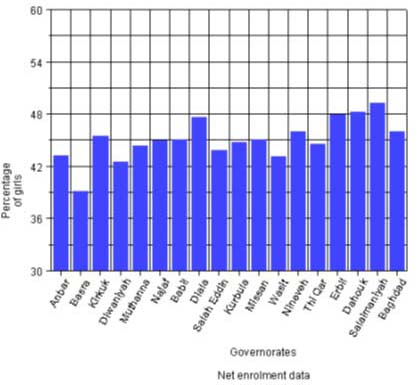
Figure 2: Girls decline in numbers. Grade
6 compared to Grade 1
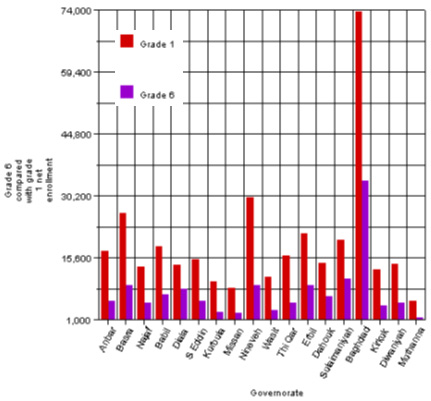
Figure 3: Girls decline in numbers. Grade 6
compared to Grade 1
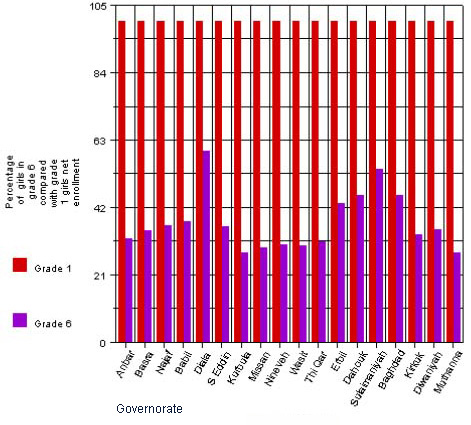
Figure 4: Percentage drop in the number
of girls between Grades 1 and 2
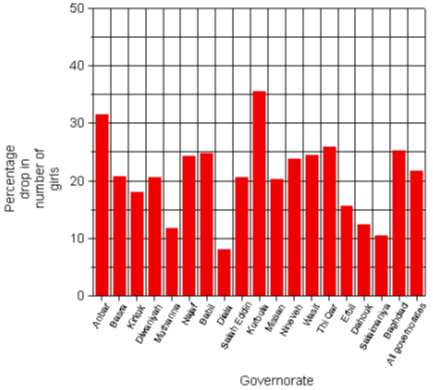
Figure 5: Percentage drop of number of girls
between Grade 6 and 1st intermediate
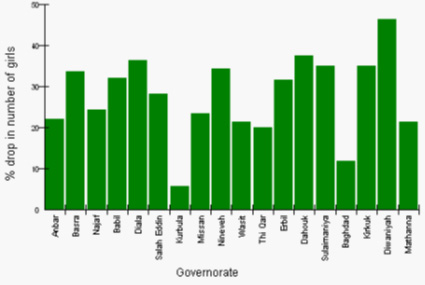
Figure 6: Percentage of girls in 1st Intermediate
class as compared with Grade 1
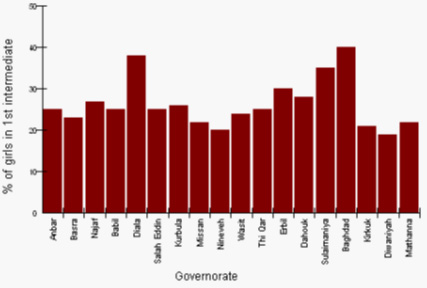
Figure 7: Decline in numbers in net enrolment
of girls - Grade 1 to 3rd intermediate
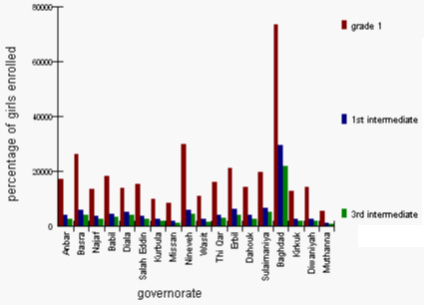
Figure 8: Girls decline in numbers - Grade
1 to 3rd intermediate class
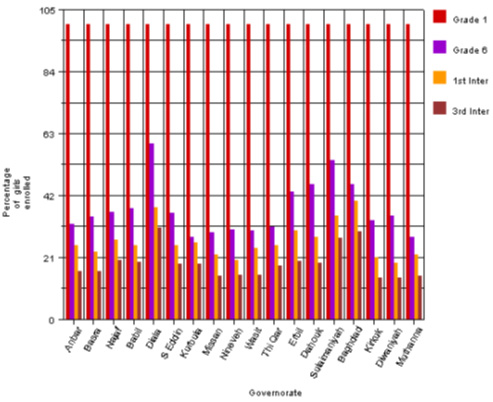
Figure 9: Difficulties in school access
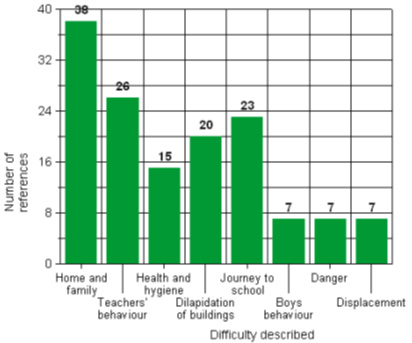
References
and
bibliography
for
this
report
Access
t1o
Education
in
Iraq:
A
Gender
Perspective,
OCHA
Iraq/UNAMI
(Information
Analysis
Unit
2008
Al-
Jawaheri,
Yasmin
Husein.
Women
in
Iraq:
The
Gender
Impact
of
International
Sanctions
2008
The
Arab
Human
Development
Report
2005.
United
Nations
Development
Programme
Arab
Fund
for
Economic
and
Social
Development,
Arab
Gulf
Programme
for
United
Nations
Development
Organizations
Baghdad
Burning:
Girl
Blog
from
Iraq,
by
Riverband,
published
by
Marion
Boyars
2005
Comprehensive
Food
Security
and
Vulnerability
Analysis
in
Iraq.
United
Nations
World
Food
Programme,
2008
Country
Reports
on
Human
Rights
Practices.
Released
by
the
Bureau
of
Democracy,
Human
Rights,
and
Labour
February
28,
2006
De-Baathification
of
Iraqi
Society,"
May
16,
2003
[online].
Educational
statistics
in
Iraq
2003-2004.
Republic
of
Iraq,
Ministry
of
Education
in
collaboration
with
UNICEF
Educational
statistics
in
Iraq
2007-2008.
Republic
of
Iraq,
Ministry
of
Education
in
collaboration
with
UNICEF
Foran,
Siobhán;
Access
to
Education
in
Iraq:
A
Gender
Perspective,
OCHA
Iraq/UNAMI
(InformationAnalysis
Unit
2008)
Haddad,
Subhy.
'New
school
year
begins
in
Iraq
amid
parents'
fresh
worries'
www.chinaview.cn
2009-09-28
Harris
Dale
B.
Goodenough-Harris
Drawing
Test.
Children's
Drawings
as
Measures
of
Intellectual
Maturity
(1963).
Iraq
Multiple
Indicator
Cluster
Survey
2000
Iraq
Multiple
Indicator
Cluster
Survey
2006
Multiple
Indicator
Cluster
Survey
2006:
volume
1
Final
report
Official
Website
of
the
Multi-National
Task
Force.
Http://Www.Mnf-Iraq.Com/Index.Php
Rassam,
Amal.
Political
ideology
and
women
in
Iraq:
Legislation
and.
Cultural
constraints,
Journal
of
Developing
Societies,
vol.
8,
1992
Rekindling
Hope
In
A
Time
of
Crisis.
A
Situational
Analysis.
UNICEF
2007
Revolutionary
Command
Council
Law
No.
139,
December
9,
1972
Coalitional
Provisional
Authority
Order
No.
1
Suad,
Joseph,
"Elite
Strategies
for
State-Building:
Women,
Family,
Religion
and
State
in
Iraq
and
Lebanon,"
in1
Women,
Islam
and
the
State,
ed.
Deniz
Kandiyoti
(Leiden,
The
Netherlands:
E.J.
Brill,1992),
p.
178-79
Survey
of
children
who
drop
out
of
school.
Ministry
of
Education
and
UNICEF;
Sri
Lanka
2009
UNDP/Ministry
of
Planning
and
Development
Coordination:
Iraq
Living
Conditions
Survey.
UNFPA:
United
Nations
Population
Fund
website
|

